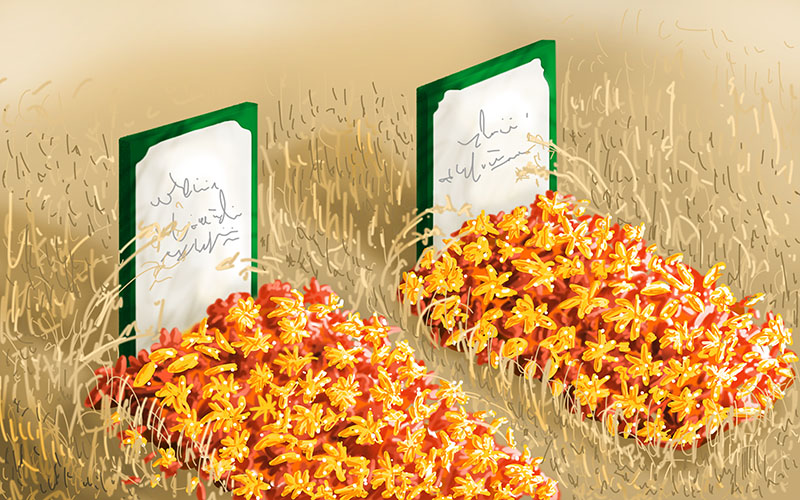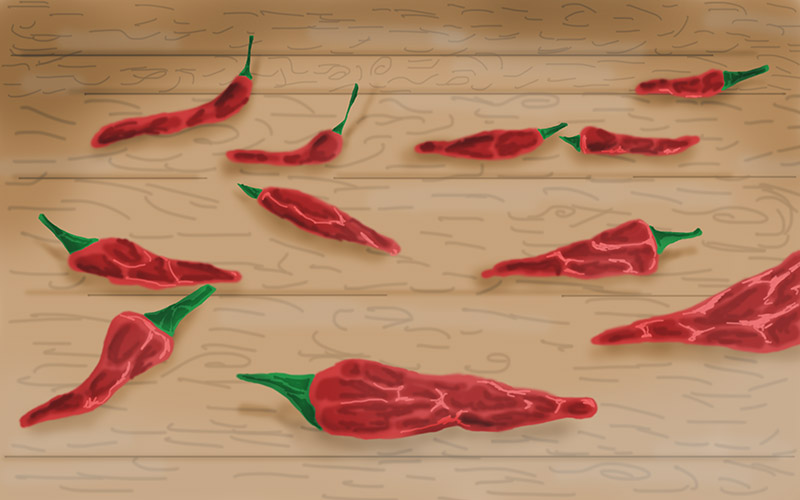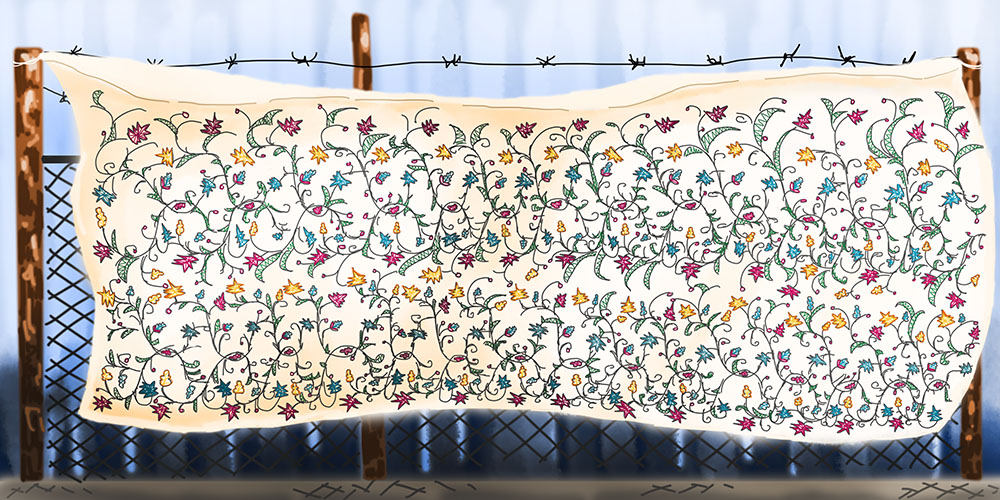In my time wandering the city of Srinagar with my host Hilal, we attempted a hike up the Shankaracharya Hill. A temple built in the 14th century for Lord Shiva sits at the peak and is an important site for the Hindu population of the city. We could have taken an auto-rickshaw, but the fare was unreasonable, considering that I was one of the few tourists in Srinagar that day.
“Can we trek to the top?” I asked Hilal in Hindi.
“I’ve never trekked up, I don’t know the way, but we’ll find it,” he said.
When the Hill finally came into view, we stared. Shankaracharya is less a hill and more of a mountain that couldn’t quite keep up with the rest of the Himalayas. Hilal laughed, an eternal enthusiast, and tied his shoelaces tighter.
One of the first things I noticed about Hilal was his shoes. He was wearing grey, white, and orange sneakers with flat soles. They were very modern. He wore them with jeans and his pheran, the long, oversized woolen coat that keeps Kashmiris warm in the winter. The pheran is an iconic symbol of Kashmiri culture, a standard component of daily ensembles. Many of the media photos taken in Kashmir show men standing with serious expressions on their faces, arms tucked inside their pherans. This is a man who is suffering, a picture headlining a piece on the innocent Kashmiris trapped in the middle of conflict could say. But this is a dangerous man, who could be a militant, say the photos of the popular, mainstream Indian media that cover the friction between the Indian Army and the Kashmiris. No one shows — or perhaps, no one seems to notice, with the pheran taking up the focus — the footwear. Hilal would not be a very good subject for either type of photo from Kashmir. His smile is too warm and his sneakers too stylish.
“Kya aap chadpaoge?” Hilal asked me. Will you be able to climb? I responded with uninformed enthusiasm.
So we trekked, losing our way and finding it again. We reached only halfway before we were winded. Hilal sat on a rock and lit a cigarette.
“I thought you wanted a darshan. We can still climb,” he said, thinking that I wanted to pray to Shiva at the top of the hill, but truly, I’m agnostic. I just wanted to see the view of Srinagar.
I turned to look at the city, but it was enveloped in the persistent late December fog, adding a film of gloom to the black, brown, and grey architecture. This was all once regal and elegant, but over the last seven decades, it all became ominous with the Indian Army stationed everywhere. I could only hear the noon namaaz playing on the loudspeaker of a nearby mosque.
At the base of Shankaracharya Hill sits the Muslim cemetery, which was not mentioned in accounts of travelers who take the auto-rikshaw. I thought of it as a profound converging of faiths. We passed a group praying near a grave. They had placed red, orange, and yellow flowers on the stone. They were vivid against all the grey, the first true display of color that I had seen in my time in Srinagar. I didn’t have it in me to wake up at dawn on a December morning to see the floating market on the city’s famous Dal Lake, where these flowers were sold. But it made me consider before we walked on if the Kashmiri people will accept such brilliant color for themselves only at the end.

•
The conflict in Kashmir is one entangled in the thorns of the Himalayan forests and the barbed wire enclosing city neighborhoods. The Kashmir region sits between India and Pakistan and is occupied by both countries, serving as their battleground. The heavily armed Line of Control splits their shares, though international boundaries encompass the entirety of Kashmir in India. But, the conflict is not only about territory and political differences between rival countries. It is also embedded deeply in historical religious tensions between Hindus and Muslims.
As an Indian-American, I have always understood the conflict only superficially. My parents sporadically brought it up in conversations with family friends in the US.
“Did you read about what happened in Kashmir?” they’d say to each other on a day like February 14, 2019, when a suicide bomber drove a car full of explosives into a group of Indian Army convoys. They’d pause and ponder, dipping biscuits into chai and then comment from afar — in the air of faux expertise — on the details of a mysterious region that seems, these days (and perhaps, one could argue, since its inception) to only exist in the news. Then, after a few moments of discussion, they’d transition into more neutral territory, like the weather in Gujarat, before any great disagreements broke out.
•
I made my first visit to Kashmir in June 2017. I was on a publicity road trip with an education nonprofit. We had stopped at a girls’ school in Srinagar. I remember how they asked us questions for hours, not only about our program but also about our lives in Pune, the city where I worked and lived at the time.
In a video interview, a student became emotional.
“No one visits us. They’re too scared to come to Kashmir. So thank you for coming, it means a lot to our school,” she said. She began to cry.
Our cameraman stopped recording and busied himself with wrapping up the microphone cord. We lost empathy, searched for it clumsily, and decided to stay silent instead.
We were only in Srinagar for a few hours before we made our way to the western Ladakhi region. During this time, I noted three things. First, the military was everywhere. Stationed every 100 meters was an Indian Army jawan in full uniform. There is only one road in and out of the valley, and we registered our names with “authorities” many times, some real, others stopping us for bribes. Second, the few tourists in the city stayed on one side of town, skirting the iconic Dal Lake. Third, other than the sound of traffic, it’s a quiet city. Everyone was always moving with their heads down, stopping to speak to a friend passing by for only a moment. I decided then to go back to Srinagar for a longer stay. I booked flights a year a half later, in December 2018.
Kashmir is a place where the mundane has slipped through the lines. The Kashmiri identity has been sealed into photographs of suffering, violence, and oppression, boxed into accounts of bomb blasts and in the comments they give the media, with their arms tucked inside their pherans.
It is only this and nothing else. There’s no reference to the way they leave red chilies out to dry in the December sun for days on the patio. Or to the professors who teach mathematics at the University and the students who anxiously ask their friends for notes before exams. Or to the way that the waiters roll their eyes when tourists order the saffron tea called kahwa (It’s usually made on special occasions, but I drank it as often as I could).
In conflict-prone regions around the world, the “protest photo” and the accounts of intense suffering are powerful, important. But, in a place like Kashmir, where conflict has been its only motif, the images and accounts of the everyday become integral in remembering the region’s human identity.

•
Though he is charming in person, Hilal was exceedingly serious on the phone, with a deep, no-nonsense voice. An acquaintance had met him on a train in Delhi. He gave me his number, just in case.
“It’s good to have a contact in Kashmir,” he said, “In case you get . . . lost.”
I called Hilal the night before my flight to Srinagar for a hotel or guesthouse recommendation. When he learned that I was traveling alone, he offered that I stay with his family, not out of concern for my safety, but because he thought it was a lonely way to travel.
“What will you do, wandering the city alone?” he asked me.
He addressed me in his most formal Hindi. I admit that I hesitated at his offer. My Hindi was weak, so weak that I would most likely offend him and his family by using the wrong verb tenses after forgetting the formal “you” conjugations.
In addition to this, I’m not usually a people person.
Then he brought God into the conversation.
“Inshallah, hum kal milenge,” he said. God willing, we will meet tomorrow. I was flattered, though it is common for Muslims to say this. But no one had ever brought God into the prospect of meeting me. I suddenly felt like a child who was told that she’s special and the most that I could do was reply with a lame, “Yes, ok, bye!”
•
Friends and family were, understandably, not thrilled by my decision to go to Kashmir. I remember telling an uncle when I came back to Pune about my visit. Now he goes around and tells people, as if it some sort of brave accomplishment, that his niece went to Kashmir alone and stayed with a family! Can you believe it! (No, they could not believe it.)
Srinagar is not a popular travel destination, as it once was when its natural beauty first came to the screen via Bollywood, India’s film industry, that seemingly transcends geopolitical and religious divisions in South Asia. Indians and foreigners went to the “Switzerland of India” for the Dal Lake, tulips, skiing, and Mughal gardens. It became popular for honeymooners. Then, the region grew violent in the 1980s and ’90s and travelers were advised to stay away. Tourism has decreased drastically since.
Kashmir has been marinating in war since its birth. The region has thousands of Indian troops and is one of the most militarized places in the world. Rahul Pandita, author of his heartbreaking memoir Our Moon Has Blood Clots, traces the origin of tensions in the region back to the 14th century, to the times of Sultan Sikander. But Kashmir has been slowly calming down – that is, before India’s Prime Minister Narendra Modi sent in thousands of more troops in early August 2019 when he revoked Article 370. Now, it’s back in its explosive state.
The Indian media is selective about what news slips through the state’s boundaries to the rest of the country. It attempts to keep the general Indian population afraid of Kashmir and convinced that innumerable anti-India militants and terrorists are hiding in Kashmiri homes. It attempts, above all, to justify Kashmir’s excessive militarization. Though this has been slowly changing, this has been the pattern of the media for decades.
In my research, it grew apparent that India receives a steady saline-drip of terror and suffering from the Kashmir valley. The problem is that every piece of Indian journalism that comes out of Kashmir is intense, as is the case with most conflict regions in the world. Everyone is either sinister or afraid or angry, always. Women hold up paper signs and scream into the camera. It seems as though every week, a photo is released of men who cover their faces with checkered handkerchiefs as they throw stones at the Army near the Jamia mosque. In videos, the scenes are like this: the Army jawan kicks open a door and searches a home for a hidden militant, gun poised, while the old Kashmiri woman sits on the floor in the living room and weeps. Stories capturing less extreme moments are rare, but that does not mean that they do not exist, or that they are unimportant.
To balance the terror, I read traveler accounts. Though there are very few, they detail all the in-between, all that we outsiders would consider “normal.” They logically counter the impression that the world seems to have of Kashmiris waking up, throwing bombs, clashing with the Army, and then going to sleep again. Don’t these people eat? Don’t they go to school and the market? Don’t they celebrate festivals? I imagine the travelers before me thinking as they booked their buses and flights to the valley.
The media had left me cold, afraid, doubting myself. The traveler stories of the everyday routines and the cultural histories gave me courage again.

•
The evening after my phone call with Hilal, I was in sitting on the floor of his living room — which had an abundance of dark embroidered rugs — with his family, shivering under a giant blanket, waiting for the power to come back on. Power cuts in Kashmir are daily occurrences, even in the winter. Hilal had said something about frozen wires and panels and mismanagement.
It must have been 30-something degrees inside. I eyed the ancient electric heater that sat by our feet, wishing for its exposed wires to glow orange, ready to set blankets on fire. It was a precarious thing, though common in Kashmiri homes as a “modern” method of heating. I expected that it would zap me the moment I went to turn it on.
I’d be in the news feed to the rest of India: Officials confirm that tourist’s death was caused by electrocution, not militants.
Ruby, Hilal’s five-year-old niece, was avoiding her tutor Aiza’s mathematics lesson by playing hide-and-seek, sending her mother, Tasleema, and Aiza on an exasperated search from room to room. Ruby’s grandfather, knowing that there would be no studying today, turned on the news. The news, in this home, was always on. There was a brief pause from it in the early afternoons for a Hindi drama, which Tasleema watched with a cup of salty Kashmiri black tea with milk, called namkeen chai. Then, the channel was turned again to the news. It was all in Kashmiri, so I couldn’t understand it, but Tasleema translated from time to time.
The anchorman was standing by the iconic Dal Lake, holding up a piece of ice. He was saying something about the cold and grey of December. The grandfather switched to another news channel. A Kashmiri son and his mother were in serious discussion about the influence of “Western values” on the youth.
These were the stories that were for only the Kashmiris. No one outside the valley would know about the ice on the Dal or the impact of the West on youth identity. They’d instead, know nothing but encounters between the Army and suspected militants.
Ruby ran to the living room, pink in the face from laughing hysterically, and hid under a heap of blankets.
“She doesn’t study, we have to yell at her, but she doesn’t listen to that either,” Tasleema said, attempting to pull the blankets off Ruby, who held onto them with her life.
Ruby grabbed Hilal’s phone, held it close to her face, assumed the kind of focus that once belonged to books, and tapped open a game.
“She only wants the phone. She doesn’t even paint. We bought her so many colors for that!” Tasleema said.
I laughed, imagined the news again. Smartphones pose great threat to Kashmiri youth. Army puts curfew on smartphone usage. Any child or teenager seen with a phone after five pm will receive a serious punishment.
Tasleema said something to Aiza in rapid Kashmiri. Aiza turned to me and invited me to her home. She lived next door to the family with her roommate Rahiba. They were both studying nursing at Kashmir University.
The full moon was our only source of light as we walked the narrow path to her building. Rahiba opened the door, holding a candle up to her round, smiling face. They welcomed me profusely, the way that the Kashmiris do.
Rahiba held my hand, telling me repeatedly that she was happy I was visiting them. It’s something that I heard often in my three years living in India, but very few meant it the way that Rahiba and Aiza did. I remembered the students from the girls’ school in Srinagar, who had greeted us with the same warmth and emotion. I thought back to my hesitation when Hilal invited me to stay with his family. I was worried that I would offend them with my bad Hindi and lack of general grace, but it seemed enough for them that I made the trip.
“Wait, I’ll bring you a hot water bottle,” said Aiza in Hindi, noticing me slowly folding into myself from the cold, and she disappeared into a dark corner of the apartment.
Rahiba scrolled through her phone and showed me a video of their recent trip to Pahalgam, a tourist town three hours from Srinagar, frequented for its skiing.
“You should have gone to Pahalgam. You would have seen snow,” said Rahiba. She and her friends were singing along to an old Bollywood song in the car. The cinemas of Srinagar, once incredibly beautiful buildings, have all been closed down. But Bollywood remains a persistent force.
Her screen lit up with a video call.
“Do you want to meet my boyfriend?” she asked me. Without waiting for an answer, she turned her phone screen to me. Her boyfriend greeted me with a serious head nod.
“Dekho kaun aaya hai! Kanan Poona se aayi hai, Srinagar ghoomne,” Look who’s here! Kanan is visiting from Pune, to see Srinagar, Rahiba said to him.
“Salaam waleikum,” he said, “How do you like Srinagar?”
I hesitated. I assumed the answer to this standard travel question required more than a simple, enthusiastic “yes” in this context. I thought to say something a little more meaningful, to show that I was learning. I devised the rather dramatic, “Kashmir doesn’t deserve the hell it’s going through.” But I couldn’t find the Hindi word for “deserve.” It was not the right time to stay silent and lose empathy. My patience was running thin.
Aiza returned with a hot water bottle and put it on my feet. Rahiba pulled a blanket around my shoulders. We were suddenly old friends.
“Yes, it is so beautiful,” I said instead. Referring to Kashmir’s natural beauty is like telling a beautiful girl that she’s beautiful. She already knows it. The world already knows it. The thought is redundant, well-established. But he smiled at that, happy with my answer. Perhaps, being reminded of beauty is sometimes a good distraction from other, more serious problems.
Rahiba turned the phone back to her and spoke quickly. They were an unexpected couple. Rahiba laughed and chattered nonstop, teasing him often, while he, ever-serious, nodded in pixels at her, freezing on the screen from time to time. Internet is a controlled thing in Kashmir, turned off in times of conflict and turned on again like a light switch in a room frequently visited. The rest of the time, it’s like a weak, flickering light bulb.
Aiza scowled when Rahiba burst out laughing.
“She talks to her boyfriend ten times a day. Do they really have that much to talk about?”
“He’s nice, right?” Rahiba asked me when she hung up, not quite because she needed approval.
“We have to keep our relationship a secret. Abu would kill me if he knew, but it’s worth it.”
Islam in Kashmir is deeply conservative and forbids romantic relationships, but, college kids remain college kids. Aiza, perhaps a bit more religious than Rahiba or perhaps, just a bit jealous, rolled her eyes.
“Who cares about boyfriends right now, I just want to study. Maybe soon I’ll go to Bombay . . . ” she trailed off, sullen.
We sat for an hour, talking. There was still no electricity when Hilal knocked on the door.
“Chalo, we have to go buy you a shawl,” he said. His friend, a Kashmiri shawl distributer, was opening up his stockroom for me that evening. Though these shawls are expensive, they represent Kashmir’s oldest industry and tradition. Leaving Kashmir without buying a hand-embroidered shawl is simply not done.
“Aap aao kabhi, humare ghar,” said Aiza as we all stood to say goodbyes. Come to our home sometime. The girls were going back to their family homes the next day, for the winter holidays.
“Yes, you’ll see only dishum dishum there. We’re from Anantanag, I’m sure you’ve heard of it,” said Rahiba, as she fired an invisible gun at each dishum and let out a dry laugh.
“Rahiba!” Aiza smacked her shoulder.
“What? It’s true!” said Rahiba, “Yes, but if you can, come visit us sometime!”
Had I traveled to Kashmir simply to be reminded that the people still attempt to live their lives beyond the conflict, though it has fundamentally taken away their ability to live freely? Listening to a stranger talk about her boyfriend seems like a ridiculous thing to travel for. And yet, without Hilal, his family, Rahiba and Aiza, I would have missed the important, uncomplicated truths, the ones that disappear in the times that they are needed the most. •




